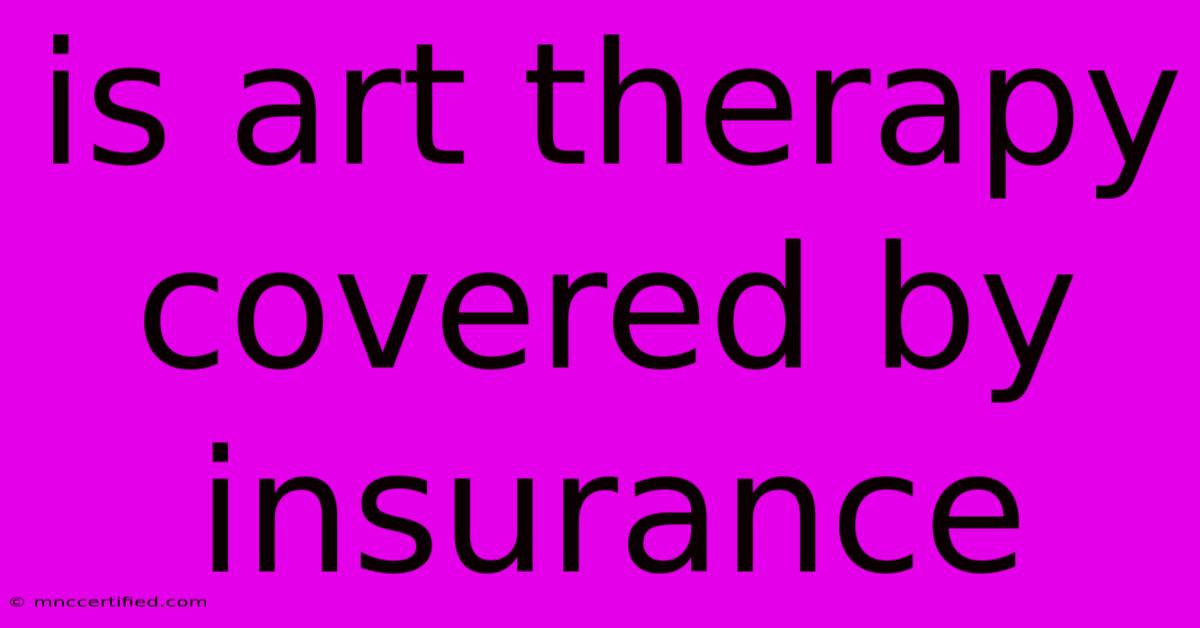Is Art Therapy Covered By Insurance

Table of Contents
Is Art Therapy Covered by Insurance? A Guide to Understanding Your Coverage
Art therapy has gained significant recognition as a valuable tool for mental and emotional well-being. However, knowing whether your insurance plan covers art therapy can be a confusing process. This guide will break down the factors influencing coverage, provide tips for navigating insurance inquiries, and offer alternative solutions if you don't have coverage.
Understanding Insurance Coverage for Art Therapy
The availability of insurance coverage for art therapy varies greatly depending on several factors:
1. Insurance Provider: Different insurance companies have diverse policies regarding coverage for art therapy. Some may include it as a covered benefit within their mental health plans, while others might exclude it entirely.
2. Plan Type: The specific type of insurance plan you have can impact coverage. For example, health maintenance organizations (HMOs) often have stricter guidelines and limited networks compared to preferred provider organizations (PPOs), which may offer more flexibility in choosing therapists.
3. State Laws: Certain states have laws requiring insurance plans to cover art therapy as a mental health benefit. However, the implementation and specifics of these laws can vary.
4. Medical Necessity: In many cases, insurance companies will require documentation proving the medical necessity of art therapy. This typically involves a diagnosis from a licensed mental health professional outlining how art therapy aligns with your treatment plan.
How to Verify Coverage
1. Contact your insurance company: The most direct way to confirm coverage is by contacting your insurance provider directly. Ask specifically about coverage for "art therapy" or "creative arts therapy".
2. Review your policy documents: Carefully examine your policy documents for any mentions of mental health coverage or alternative therapies. Look for terms like "mental health services," "psychotherapy," or "creative arts therapy."
3. Consult a mental health professional: A qualified mental health professional can help you understand your coverage options and provide guidance on navigating the insurance process.
Alternatives If Coverage is Limited
1. Out-of-pocket payment: If insurance coverage is unavailable, you can consider paying for art therapy sessions out-of-pocket.
2. Sliding scale fees: Some art therapists offer sliding scale fees based on income, allowing for more accessible sessions.
3. Group therapy: Group art therapy sessions can often be less expensive than individual sessions.
4. Online platforms: Several online platforms connect individuals with licensed art therapists offering affordable sessions.
5. Fundraising: Consider organizing a fundraiser or exploring online platforms designed for medical expenses to help cover the costs of art therapy.
Tips for Maximizing Coverage
1. Obtain a referral: A referral from your primary care physician or a mental health professional can strengthen your case for coverage.
2. Prepare documentation: Ensure you have all necessary documentation, including a diagnosis and treatment plan, to support the medical necessity of art therapy.
3. Explore different therapists: Consider contacting multiple art therapists to inquire about their insurance policies and acceptance of your plan.
4. Advocate for yourself: If your claim is denied, be prepared to appeal the decision by providing additional documentation or seeking assistance from a patient advocate.
Conclusion
Navigating insurance coverage for art therapy can be a challenging process, but understanding the factors influencing coverage and following the tips above can increase your chances of obtaining support. Remember, art therapy offers a valuable pathway to healing and well-being, and it's worth exploring all options to make it accessible.

Thank you for visiting our website wich cover about Is Art Therapy Covered By Insurance. We hope the information provided has been useful to you. Feel free to contact us if you have any questions or need further assistance. See you next time and dont miss to bookmark.
Featured Posts
-
Virginia Builders Insurance Company
Nov 14, 2024
-
Paddy The Ride Of My Life Release Date And Interview
Nov 14, 2024
-
Hes Everything Spurs Fans Support Popovich
Nov 14, 2024
-
How To Look Up Someones Insurance Information
Nov 14, 2024
-
Republicans Elect Thune As Senate Leader
Nov 14, 2024